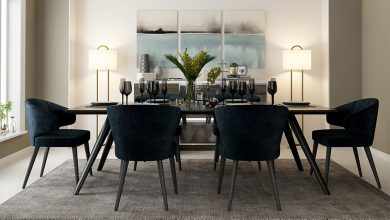Title: 9 Decor Mistakes That Are Making Your Home Look Smaller

Meta-Description: Discover the 9 decor mistakes that can unintentionally make your home appear smaller than it actually is. Avoid these common pitfalls and learn how to create the illusion of spaciousness in your living space.
Introduction: Creating the Illusion of Space
Having a spacious and open home is a dream for many homeowners. However, sometimes the way we decorate and arrange our living spaces can inadvertently make them feel smaller than they actually are. Fortunately, by avoiding a few common decor mistakes, you can transform your home into a visually expansive and inviting oasis. In this article, we will explore nine decor mistakes that are making your home look smaller and provide practical solutions to overcome them. So, let’s dive in and discover the secrets to maximizing space in your living areas!
1. Clutter Overload: The Enemy of Space
Sub-heading: The Impact of Clutter on Perceived Space
One of the biggest culprits behind a cramped-looking home is clutter. When our living spaces are filled with excessive belongings, it’s easy for them to appear smaller and more congested. The first step in creating a spacious atmosphere is to declutter and organize your home. Clear out unnecessary items, find proper storage solutions, and keep surfaces clean and tidy. By doing so, you’ll instantly create an illusion of more space and allow your decor to shine.
2. Oversized Furniture: A Sizeable Problem
Sub-heading: The Downside of Oversized Furniture
While big, plush furniture may seem luxurious, it can overpower a small space and make it feel cramped. Opting for furniture that is appropriately scaled to your room is essential. Consider sleek and multifunctional pieces that maximize both comfort and space. Sofas with raised legs or transparent elements can create an open and airy feel. Remember, it’s better to have a few well-chosen furniture items than to cram your space with oversized pieces that dominate the room.
3. Poor Lighting Choices: Diminishing Your Space
Sub-heading: Brightening Up Your Home
Lighting plays a significant role in how spacious a room appears. Insufficient or poorly placed lighting can cast shadows and make your home feel smaller. To combat this, aim for a mix of natural and artificial light sources. Use sheer curtains or blinds to allow maximum natural light to filter in. Strategically place lamps and fixtures to eliminate dark corners. Mirrors can also be employed to reflect light and create the illusion of depth, instantly expanding the visual boundaries of your room.
4. Neglecting Vertical Space: A Missed Opportunity
Sub-heading: Utilizing Vertical Space for Maximum Impact
When striving to make your home appear larger, it’s important not to overlook vertical space. Embracing the height of your walls can be a game-changer. Install tall bookshelves or vertical storage units that draw the eye upwards. Hanging curtains closer to the ceiling rather than just above windows can create the illusion of higher ceilings. Artwork or wall decor that spans vertically will also elongate the walls, giving the impression of more space.
5. Dark Color Dominance: An Illusion of Constriction
Sub-heading: The Impact of Dark Colors on Space Perception
While dark colors can add depth and drama to a room, they tend to absorb light and make a space feel smaller. To counteract this effect, opt for light and neutral hues for your walls and larger furniture pieces. Lighter shades reflect light, creating an airy ambiance. You can still incorporate darker tones as accents or through smaller decor items to add contrast without compromising the perceived spaciousness of your home.
6. Disorganized Layout: Traffic Jams at Home
Sub-heading: The Importance of Efficient Room Layouts
The way you arrange furniture and create traffic flow within your home can significantly impact its perceived size. Avoid obstructing pathways with oversized furniture or cluttered arrangements. Instead, opt for an open and functional layout that allows for easy movement. Consider the natural flow of the room and ensure that your furniture placement enhances this flow, rather than hindering it. By organizing your space effectively, you’ll create a more open and welcoming environment.
7. Lack of Mirrors: Reflecting on Space
Sub-heading: The Expanding Power of Mirrors
Mirrors are a versatile tool in creating the illusion of space. By strategically placing mirrors in your home, you can reflect light, visually expand the room, and create a sense of depth. Large mirrors on walls or leaning against them can give the impression of a larger space. Consider placing mirrors opposite windows to reflect natural light and bring the outdoors inside. Embrace the magic of mirrors and watch your home transform.
8. Neglected Ceilings: Overlooking the Fifth Wall
Sub-heading: Elevating Your Space with Ceilings
Often overlooked, ceilings present an opportunity to add visual interest and height to your home. Embrace your fifth wall by incorporating decorative elements such as ceiling moldings or patterns. Vertical stripes or beams can elongate the room, making it feel more expansive. Experiment with textured or painted ceilings to draw the eye upwards and add a touch of elegance. By paying attention to your ceilings, you’ll be surprised by how much larger your space can appear.
9. Lack of Personalization: Tailoring to Your Style
Sub-heading: Customizing Your Space for Optimal Comfort
While it’s important to follow design principles to create the illusion of space, it’s equally vital to infuse your personality into your home. A lack of personalization can result in a sterile and unwelcoming environment. Find a balance between space-enhancing decor and meaningful objects that reflect your taste and memories. Incorporate artwork, photographs, or unique items that bring joy and tell your story. When your home feels like an extension of yourself, it becomes a place of comfort and spaciousness.
FAQs:
Q: Will decluttering alone make my home feel larger?
A: Decluttering is a crucial first step in creating a spacious atmosphere, but it should be combined with other techniques. Pay attention to lighting, color choices, and furniture scaling to maximize the perceived space in your home.
Q: Can dark colors be used in small spaces?
A: Dark colors can be used as accents or smaller decor items to add depth and contrast. However, it’s advisable to choose light and neutral hues for walls and larger furniture to maintain a sense of openness.
Q: How can I make a narrow hallway appear wider?
A: Painting the walls a light color and utilizing mirrors at the end of the hallway can visually widen the space. Additionally, avoid clutter and opt for sleek furniture or wall-mounted storage to create a more spacious feel.
Q: Will removing walls make my home appear larger?
A: Removing walls can create an open-concept layout that visually expands your home. However, consult with a professional to ensure structural integrity and consider alternative solutions like half walls or glass partitions to maintain some separation while maximizing space.
Q: Can plants make a small space feel larger?
A: Indoor plants can add a refreshing touch to any space, but be mindful of the size and placement. Opt for smaller potted plants or hanging planters to avoid overwhelming the room and to maintain a sense of openness.
Q: Are there any specific lighting fixtures that can make a room look bigger?
A: Track lighting, recessed lighting, or fixtures with adjustable arms that direct light towards walls and ceilings can create the illusion of a larger space. These fixtures help eliminate dark corners and bounce light around the room, making it feel more expansive.
Conclusion: Unlock the Potential of Your Home
By avoiding these nine common decor mistakes, you can transform your home into a visually spacious and inviting haven. Remember to declutter, choose appropriately scaled furniture, and pay attention to lighting and color choices. Embrace the vertical space, utilize mirrors, and personalize your home to make it truly yours. With these tips and a keen eye for design, you’ll be amazed at how much larger your home can look and feel. Unlock the potential of your living space and create a home that welcomes you with open arms.









